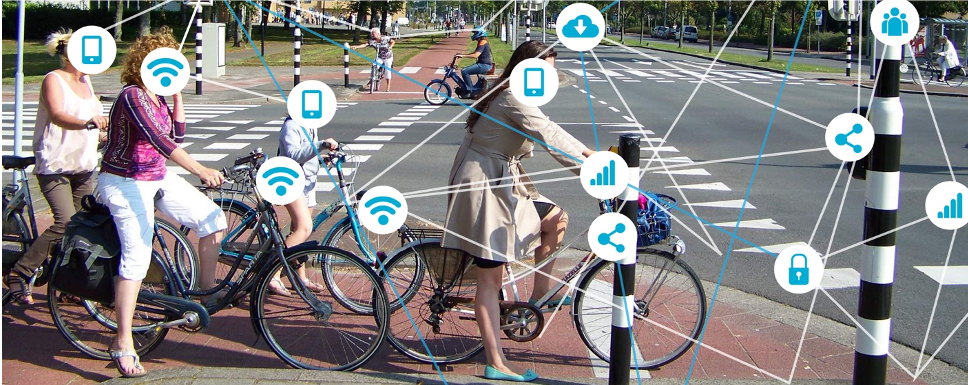BITS / ITS / Technology
Bikes and ITS: Train your data reflex

The following article is a contribution from Ronald Jorna and Robin Kleine as a part of their continued work with BITS EU, originally published in Dutch for MobiliteitsPlatform, and can be found here: https://digitals.acquire.nl/mobiliteit/mobiliteitsplatform-3-2020
Sustainability, health, accessibility and livability are some of the reasons we use to justify investments in bicycle policies. Cycling is a direct contributor to a better quality of life. More and better cycling infrastructure and parking facilities, higher priority at intersections and tax incentives; everything that can help us with our mission is put on the table. To do this effectively, though, information about the cyclist is essential. But how do we do so using a data-driven process?
Companies have been using data to gain a competitive advantage for a long time. Airlines create comprehensive profiles of travellers: using social media, frequent flyer programs and travel history, they advertise in a targeted way and even determine who the crew will talk to during the flight. Car manufacturers collect all kinds of data about the vehicle and its use: from fuel consumption and technical condition to driving style and preferred routes. This data is then used to improve their production process and services.
This gives these companies a strong edge, and not just with respect to each other. This is what we, as cycling professionals, are up against. Bicycle data is not only essential for improving cycling policies, it is also important for justifying and thus securing new investments. Fortunately, we see that cycling data is receiving increased attention. In addition to the fact that a big step forward has been taken with regard to counting data in the Netherlands through the Bicycle Open Data portal (in Dutch), we see more and more ways to collect data on cyclists.
Targeted data collection is currently the most important source of bicycle data. However, the application of ITS in cycling is creating many new possible data sources. ITS provides data by definition and, if used and interpreted correctly, this data can provide valuable insights. In order to grasp these opportunities, we must first of all be aware of them and know how to make use of them. In other words, we need to train our data reflex[1].
The four steps of the data reflex are (see figure 1):
- Available: The data-reflex starts with seeing opportunities and ensuring that data become available. This means arranging from the start that data is collected, and that you will have access to it.
- Understand: You have to understand the data, both in terms of information value and how it is technically constructed: what can you do with it and what can’t you do with it?
- Process: Data must be processed correctly. How do you convert the data into valuable information? And how do you ensure that the data can be used by others without sacrificing privacy?
- Publish: The final step consists of sharing and inspiring. By sharing data and techniques we offer each other the opportunity to learn and develop new ideas.

Figure 1: Data-reflex (bron: Steven Soetens, Provincie Antwerpen)
The data reflex is a central concept in the BITS project, as East Riding of Yorkshire Council also shows. East Riding is a municipality with virtually no bicycle facilities and bicycle use. The municipality wants to break through this by, among other things, introducing a bicycle library. Residents can borrow a bicycle that suits their needs: from ‘regular’ bicycles and e-bikes to all kinds of adapted bicycles. Bicycle coaches then literally help them on their way.
Now in comes the added value of the data reflex: by using different sensors in the bicycles to collect data on their use, local authorities gain insight into user behaviour and can invest more specifically in bicycle facilities. Their use is also analyzed on a personal level and the bicycle coaches use this to improve their approach. If someone suddenly stops using the bicycle, they can plan a conversation to determine what may have changed and if they can help. One data source provides the opportunity to address a multitude of elements in one swoop.
Data is often a ‘by-product’ of ITS applications. Dynamic bicycle path lighting turns on when a cyclist is detected and turns off again after they’ve passed. It’s a great application to save energy and reduce light pollution. However, every time a lamp goes on, a cyclist can be counted as well. An app that sets a traffic light for cyclists to green can, in combination with the control phasing of the traffic light, also provide insight into the number of red-light negations. Traffic experts who purchase ITS solutions for improving cycling conditions in their city should therefore not only look at the primary purpose of the ITS application (bicycle lending, lighting, reduced waiting time), but also at other data that can be collected via the ITS applications. Of course, the right agreements need to be made with the supplier (data format, ownership of the data, frequency of the data, etc.).
Don’t get us wrong, data and technology are not the solution to all problems. People have to make the right choices; people who believe that the world will be a better place if we look at mobility in a different way. Data and technology can support the creation of this better world. With data you can better respond to the behaviour and needs of the target group. But this requires knowledge, expertise and a positive-critical view of technology. How is your data reflex?
_________
[1] The term ‘data reflex’ was introduced in this context by Steven Soetens (Province of Antwerp) during the BITS Cycling Academy. (Antwerpen, 19 februari 2020)

Ronald Jorna
‘ICT makes the transport chain more intelligent, which contributes to more efficient and sustainable transportation. As a staunch advocate for smart travel, I investigate how ICT can increase the safety and comfort of cyclists. European cooperation and knowledge sharing are important to this work. The choice for a certain modality is a trade-off between time, cost, quality of life and health.’
Senior Advisor ICT and Freight Specialist
r.jorna@mobycon.com

